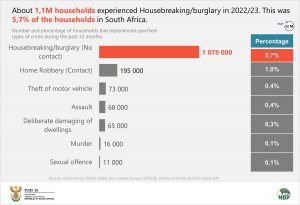Crime in South Africa up in 2022/23
New data released by Statistics South Africa shows that household crimes such as housebreaking, home robbery and theft of motor vehicles experienced in the twelve months preceding the interview increased compared to 2021/22. Crimes experienced by individuals have also increased, except for consumer fraud and hijacking of motor vehicles, which dropped in 2022/23.
According to the Governance, Public Safety, and Justice Survey (GPSJS) 2022/23, the percentage of adults aged 16 years and older who felt safe walking alone in their neighbourhoods during the day decreased from 81,3% in 2021/22 to 80,8% in 2022/23.
Housebreaking is the most common crime experienced by households in South Africa. A total of 1,1 million households experienced housebreaking incidences in the 2022/23 period. An estimated 1,6 million incidences of housebreaking occurred, representing 5,7% of all households in the country. About 51% of households that experienced housebreaking reported some or all incidences to the police. The percentage of households that reported the incidences to the police decreased from 59,2% in 2021/22 to 51,4% in 2022/23. According to the GPSJS, housebreaking was more often experienced by male-headed households than women-headed households and households in non-metro areas.
“Home robbery” is regarded as a violent crime because people are at home when it takes place as compared to “housebreaking” (burglary), which occurs when the family is away from home. The second most common type of crime experienced by households in SA is home robbery, affecting 195 000 households. An estimated 238 000 incidences of home robberies occurred in 2022/23, representing 1,0% of all households in the country. About 57% of households that experienced home robbery reported some or all incidences to the police. The percentage of households that reported some or all incidences to the police decreased from 66,4% in 2021/22 to 56,8% in 2022/23.
Strong communities are known to look out for each other. When you know your neighbours, you will be more inclined to look out for them or their property and they will do the same for you. Even if there are no official “neighbourhood watches”, when neighbours know each other well, they are more likely to be aware of the comings and goings at a property, which ensures an extra pair of eyes on their neighbours home when they are not around.
According to the United Nations Development Programme (UNDP), social cohesion has two main dimensions: reducing disparities, inequalities and social exclusion and strengthening social relations, interactions and ties.
According to the report, respondents were asked whether they know their next-door neighbours, whether they would ask their neighbours to watch their house if they were going away, whether they trust their neighbours with their children, and whether they would participate in any forums that discuss community issues.
The proportion of households who know their neighbours’ names increased from 91,9% in 2019/20 to 93,3% in 2022/23. In 2019/20 about 85,8% of the households would ask their next-door neighbours to watch their house. However, in 2022/23 this percentage dropped to 84,7%. More than 50% of the households indicated that they have no knowledge of active forums that discuss or deal with community-related issues in their areas.
The GPSJS report also covers other crimes committed such as assault, theft and hijacking of motor vehicles, deliberate damaging of dwellings, murder, sexual offences, theft of personal property, consumer fraud and feelings of safety.
For more information the report will be published here.


